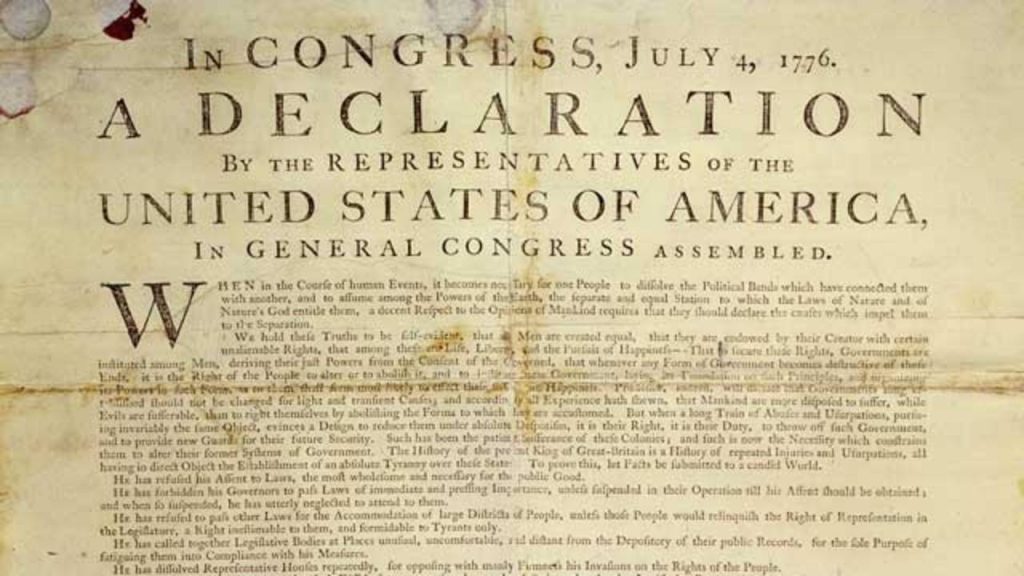Declaration of Independence: A History


Nations come into being in many ways. Military rebellion, civil strife, acts of heroism, acts of treachery, a thousand greater and lesser clashes between defenders of the old order and supporters of the new–all these occurrences and more have marked the emergences of new nations, large and small. The birth of our own nation included them all. That birth was unique, not only in the immensity of its later impact on the course of world history and the growth of democracy, but also because so many of the threads in our national history run back through time to come together in one place, in one time, and in one document: the Declaration of Independence.
Moving Toward Independence
The clearest call for independence up to the summer of 1776 came in Philadelphia on June 7. On that date in session in the Pennsylvania State House (later Independence Hall), the Continental Congress heard Richard Henry Lee of Virginia read his resolution beginning: “Resolved: That these United Colonies are, and of right ought to be, free and independent States, that they are absolved from all allegiance to the British Crown, and that all political connection between them and the State of Great Britain is, and ought to be, totally dissolved.”
The Lee Resolution was an expression of what was already beginning to happen throughout the colonies. When the Second Continental Congress, which was essentially the government of the United States from 1775 to 1788, first met in May 1775, King George III had not replied to the petition for redress of grievances that he had been sent by the First Continental Congress. The Congress gradually took on the responsibilities of a national government. In June 1775 the Congress established the Continental Army as well as a continental currency. By the end of July of that year, it created a post office for the “United Colonies.”
In August 1775 a royal proclamation declared that the King’s American subjects were “engaged in open and avowed rebellion.” Later that year, Parliament passed the American Prohibitory Act, which made all American vessels and cargoes forfeit to the Crown. And in May 1776 the Congress learned that the King had negotiated treaties with German states to hire mercenaries to fight in America. The weight of these actions combined to convince many Americans that the mother country was treating the colonies as a foreign entity.
One by one, the Continental Congress continued to cut the colonies’ ties to Britain. The Privateering Resolution, passed in March 1776, allowed the colonists “to fit out armed vessels to cruize [sic] on the enemies of these United Colonies.” On April 6, 1776, American ports were opened to commerce with other nations, an action that severed the economic ties fostered by the Navigation Acts. A “Resolution for the Formation of Local Governments” was passed on May 10, 1776.
At the same time, more of the colonists themselves were becoming convinced of the inevitability of independence. Thomas Paine’s Common Sense, published in January 1776, was sold by the thousands. By the middle of May 1776, eight colonies had decided that they would support independence. On May 15, 1776, the Virginia Convention passed a resolution that “the delegates appointed to represent this colony in General Congress be instructed to propose to that respectable body to declare the United Colonies free and independent states.”
It was in keeping with these instructions that Richard Henry Lee, on June 7, 1776, presented his resolution. There were still some delegates, however, including those bound by earlier instructions, who wished to pursue the path of reconciliation with Britain. On June 11 consideration of the Lee Resolution was postponed by a vote of seven colonies to five, with New York abstaining. Congress then recessed for 3 weeks. The tone of the debate indicated that at the end of that time the Lee Resolution would be adopted. Before Congress recessed, therefore, a Committee of Five was appointed to draft a statement presenting to the world the colonies’ case for independence.

Leave a Reply
You must be logged in to post a comment.